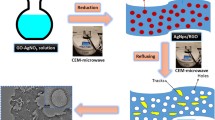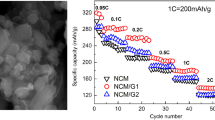Abstract
Despite having a low electrical conductivity, graphene oxide (GO) is used as an anode material in lithium-ion batteries (LIBs) owing its good processability in large quantities. GO is reduced by chemical or thermal treatments to enhance its electrical conductivity. In this study, high-performance GO anodes with polydopamine (PDA) and polyethylenimine (PEI) as binders were fabricated. Gamma (γ)-ray irradiation was applied to the GO–PDA–PEI hybrid sheets to covalently cross-link the GO sheets and binders with an amide bond. The covalent crosslinking was confirmed by Fourier-transform infrared spectroscopy analysis. Further, X-ray photoelectron spectroscopy results showed that γ-ray irradiation produced a reduced GO sheet, which resulted in an increase in the electrical conductivity by 30%. By characterizing the electrochemical properties, we found that the γ-ray irradiation facilitates the stability and increases the charge/discharge capacity by crosslinking GO and PDA–PEI binders and reducing the GO sheets.





Similar content being viewed by others
References
Chang X, Xie Z, Liu Z, Zheng X, Zheng J, Li X (2020) Aluminum: an underappreciated anode material for lithium-ion batteries. Energy Storage Mater 25:93–99. https://doi.org/10.1016/j.ensm.2019.10.027
Jiang Y, Zhang D, Li Y, Yuan T, Bahlawane N, Liang C, Sun W, Lu Y, Yan M (2014) Amorphous Fe2O3 as a high-capacity, high-rate and long-life anode material for lithium ion batteries. Nano Energy 4:23–30. https://doi.org/10.1016/j.nanoen.2013.12.001
Zhang W-M, Wu X-L, Hu J-S, Guo Y-G, Wan L-J (2008) Carbon coated Fe3O4 nanospindles as a superior anode material for lithium-ion batteries. Adv Funct Mater 18:3941–3946. https://doi.org/10.1002/adfm.200801386
Guo P, Song H, Chen X (2009) Electrochemical performance of graphene nanosheets as anode material for lithium-ion batteries. Electrochem Commun 11:1320–1324. https://doi.org/10.1016/j.elecom.2009.04.036
Xiao J, Choi D, Cosimbescu L, Koech P, Liu J, Lemmon JP (2010) Exfoliated MoS2 nanocomposite as an anode material for lithium ion batteries. Chem Mater 22:4522–4524. https://doi.org/10.1021/cm101254j
Lin L, Xu X, Chu C, Majeed MK, Yang J (2016) Mesoporous amorphous silicon: a simple synthesis of a high-rate and long-life anode material for lithium-ion batteries. Angew Chem Int Ed Engl 55:14063–14066. https://doi.org/10.1002/ange.201608146
Wang H, Cui Li-F, Yang Y, Casalongue HS, Robinson JT, Liang Y, Cui Y, Dai H (2010) Mn3O4-graphene hybrid as a high-capacity anode material for lithium ion batteries. J Am Chem Soc 132:13978–13980. https://doi.org/10.1021/ja105296a
Zhu X, Zhu Y, Murali S, Stoller MD, Ruoff RS (2011) Nanostructured reduced graphene oxide/Fe2O3 composite as a high-performance anode material for lithium ion batteries. ACS Nano 5:3333–3338. https://doi.org/10.1021/nn200493r
Wu L, Zheng J, Wang L, Xiong X, Shao Y, Wang G, Wang J-H, Zhong S, Wu M (2019) PPy-encapsulated SnS2 nanosheets stabilized by defects on a TiO2 support as a durable anode material for lithium-ion batteries. Angew Chem Int Ed Engl 58:811–815. https://doi.org/10.1002/ange.201811784
Cao X, Shi Y, Shi W, Rui X, Yan Q, Kong J, Zhang H (2013) Preparation of MoS2-coated three-dimensional graphene networks for high-performance anode material in lithium-ion batteries. Small 9:3433–3438. https://doi.org/10.1002/smll.201202697
Sun Y, Hu X, Luo W, Hwang Y (2011) Self assembled hierarchical MoO2/graphene nanoarchitectures and their application as a high-performance anode material for lithium-ion batteries. ACS Nano 5:7100–7107. https://doi.org/10.1021/nn201802c
Kambe N, Dresselhaus MS, Dresselhaus G, Basu S, McGhie AR, Fischer JE (1979) Intercalate ordering in first stage graphite-lithium. Mater Sci Eng 40:1–4. https://doi.org/10.1016/0025-5416(79)90002-8
Abouimrane A, Comton OC, Amine K, Nguyen ST (2010) Non-annealed graphene paper as a binder-free anode for lithium-ion batteries. J Phys Chem C 114:12800–12804. https://doi.org/10.1021/jp103704y
Fu C, Zhao G, Zhang H, Li S (2013) Evaluation and characterization of reduced graphene oxide nanosheets as anode materials for lithium-ion batteries. Int J Electrochem Sci 8:6269–6280
An Y, Fei H, Zeng G, Ci L, Xi B, Xiong S, Feng J (2018) Commercial expanded graphite as a low-cost, long-cycling life anode for potassium–ion batteries with conventional carbonate electrolyte. J Power Sources 378:66–72. https://doi.org/10.1016/j.jpowsour.2017.12.033
Shen S, Wang J, Wu Z, Du Z, Tang Z, Yang J (2020) Graphene quantum dots with high yield and high quality synthesized from low cost precursor of aphanitic graphite. Nanomaterials 10:1–11. https://doi.org/10.3390/nano10020375
Jung YU, Oh S-i, Choa S-H, Kim H-K, Kang SJ (2013) Electromechanical properties of graphene transparent conducting films for flexible electronics. Curr Appl Phys 13:1331–1334. https://doi.org/10.1016/j.cap.2013.04.017
Nag A, Mitra A, Mukhopadhyay SC (2018) Graphene and its sensor-based applications: a review. Sens Actuators A 270:177–194. https://doi.org/10.1016/j.sna.2017.12.028
Chen D, Ji G, Ma Y, Lee JY, Lu J (2011) Graphene-encapsulated hollow Fe3O4 nanoparticle aggregates as a high-performance anode material for lithium ion batteries. ACS Appl Mater Interfaces 3:3078–3083. https://doi.org/10.1021/am200592r
Zhang Y, Tan Y-W, Stormer HL, Kim P (2005) Experimental observation of the quantum Hall effect and Berry’s phase in graphene. Nature 438:201–204. https://doi.org/10.1038/nature04235
Kheirabadi N, Shafiekhani A (2012) Graphene/Li-ion battery. J Appl Phys 112(1–5):124323. https://doi.org/10.1063/1.4771923
Yoo E, Kim J, Hosono E, Zhou H-S, Kudo T (2008) Large reversible Li storage of graphene nanosheet families for use in rechargeable lithium ion batteries. Nano Lett 8:2272–2282. https://doi.org/10.1021/nl800957b
Behera SK (2011) Enhanced rate performance and cyclic stability of Fe3O4-graphene nanocomposites for Li ion battery anodes. Chem Commun 47:10371–10373. https://doi.org/10.1039/C1CC13218K
Luo J, Zhao X, Wu J, Jang HD, Kung HH, Huang J (2012) Crumpled graphene-encapsulated Si nanoparticles for lithium ion battery anodes. J Phys Chem Lett 3:1824–1829. https://doi.org/10.1021/jz3006892
Yu Y-X (2013) Grapheneylene: a promising anode matrial for lithium-ion batteries with high mobility and storage. J Mater Chem A 1:13559–13566. https://doi.org/10.1039/c3ta12639k
Yu Y-X (2013) Can all nitrogen-doped defects improve the performance of graphene anode materials for lithium-ion batteries? Phys Chem Chem Phys 15:16819–16827. https://doi.org/10.1039/c3cp51689j
Yu Y-X (2014) Binding energy and work function of organic electrode materials phenanthraquinone, pyromellitic dianhydride and their derivatives adsorbed on graphene. ACS Appl Mater Interfaces 6:16267–16275. https://doi.org/10.1021/am504452a
Eigler S, Hirsch A (2014) Chemistry with graphene and graphene oxide-challenges for synthetic chemists. Angew Chem Int Ed 53:7720–7738. https://doi.org/10.1002/anie.201402780
Hummers WS, Offeman RE (1958) Preparation of graphitic oxide. J Am Chem Soc 80:1339–1339. https://doi.org/10.1021/ja01539a017
Kim H, Jang YR, Yoo J, Seo YS, Kim KY, Lee JS, Park SD, Kim CJ, Koo J (2014) Morphology control of surfactant-assisted graphene oxide films at the liquid-gas interface. Langmuir 30:2170–2177. https://doi.org/10.1021/la403255q
Gao W (2015) The chemistry of graphene oxide. In: Gao W (ed) Graphene oxide, 1st edn. Springer, Cham, pp 61–95
Jang J, Song SH, Kim H, Moon J, Ahn H, Jo K-I, Bang J, Kim H, Koo J (2021) Janus graphene oxide sheets with Fe3O4 nanoparticles and polydopamine as anodes for lithium-ion batteries. ACS Appl Mater Interfaces 13:14786–14795. https://doi.org/10.1021/acsami.1c02892
Dumee LF, Feng C, He L, Allioux F-M, Yi Z, Gao W, Banos C, Davies JB, Kong L (2014) Tunig the grade of graphene: gamma ray irradiation of free-standing graphene oxide films in gaseous phase. Appl Surf Sci 322:126–135. https://doi.org/10.1016/j.apsusc.2014.10.070
Dumee LF, Feng C, He L, Yi Z, She F, Peng Z, Gao W, Banos C, Davies JB, Huynh C, Hawkins S, Duke MC, Gray S, Hodgson PD, Kong L (2014) Single step preparation of meso-porous and reduced graphene oxide by gamma-ray irradiation in gaseous phase. Carbon 70:313–318. https://doi.org/10.1016/j.carbon.2013.12.094
He Y, Li J, Li L, Li J (2016) Gamma-ray irradiation-induced reduction and self-assembly of graphene oxide into three-dimensinal graphene aerogel. Mat Lett 177:76–79. https://doi.org/10.1016/j.matlet.2016.04.187
Zhang B, Li L, Wang Z, Xie S, Zhang Y, Shen Y, Yu M, Deng B, Qing H, Fan C, Li J (2012) Radiation induced reduction: an effective and clean route to synthesize functionalized graphene. J Mater Chem 22:7775–7781. https://doi.org/10.1039/C2JM16722K
Zhang Y, Ma H-L, Zhang Q, Peng J, Li J, Zhai M, Yu Z-Z (2012) Facile synthesis of well-dispersed graphene by γ-ray induced reduction of graphene oxide. J Mater Chem 22:13064–13069. https://doi.org/10.1039/C2JM32231E
Lv J, Wang H, Xu J, Liu Y, Zhang H, Sun J, Zhao H, Zhu C (2019) Gamma irradiation induced decomposition of polydopamine nanoparticles under ambient condition. Chem Lett 48:426–428. https://doi.org/10.1246/cl.190019
Lee H, Dellatore SM, Miller WM, Messersmith PB (2007) Mussel-inspired surface chemistry for multifunctional coatings. Science 318:426–430. https://doi.org/10.1126/science.1147241
Lv J, Wang H, Liu Y, Chen J, Chen H, Xu J, Sun J, Zhao H, Zhu C (2020) Nanocomposite enhanced radiation resistant effects in polyurethane elastomer with low fraction of polydopamine nanoparticles. Compos Sci Technol 186(1–8):107908. https://doi.org/10.1016/j.compscitech.2019.107908
Kim KJ, Kim J-H, Park M-S, Kwon HK, Kim H, Kim Y-J (2012) Enhancement of electrochemical and thermal properties of polyethylene separators coated with polyvinylidene fluoride-hexafluoropropylene co-polymer for Li-ion batteries. J Power Sources 198:298–302. https://doi.org/10.1016/j.jpowsour.2011.09.086
Kim KJ, Kim YH, Song JH, Jo YN, Kim J-S, Kim Y-J (2010) Effect of gamma ray irradiation on thermal and electrochemical properties of polyethylene separator for Li ion batteries. J Power Sources 195:6075–6080. https://doi.org/10.1016/j.jpowsour.2009.12.056
Jung C, Noh Y, Bae J, Yu J, Hwang I, Shin J, Shin K, Lee J, Choi J, Na S (2017) Polyacrylonitrile-grafted reduced graphene oxide hybrid: An all-round and efficient hole-extraction material for organic and inorganic-organic hybrid photovoltaics. Nano Energy 31:19–27. https://doi.org/10.1016/j.nanoen.2016.11.003
Jung C, Hwang I, Sohn J, Shin J (2020) Preparation and characterization of solution-processible polymer-grafted reduced graphene oxide by a radiation technology. Radiat Phys Chem 166:108504. https://doi.org/10.1016/j.radphyschem.2019.108504
Zhao Z, Li J, Wen T, Shen C, Wang X, Xu A (2015) Surface functionalization graphene oxide by polydopamine for high affinity of radionuclides. Colloids Surf A Physicochem Eng Asp 482:258–266. https://doi.org/10.1016/j.colsurfa.2015.05.020
Roy S, Hai LV, Kim J (2019) Synergistic effect of polydopamine–polyethylenimine copolymer coating on graphene oxide for EVA nanocomposites and high-performance triboelectric nanogenerators. Nanoscale Adv 1:2444–2453. https://doi.org/10.1039/C9NA00142E
Johra FT, Jung W-G (2015) Hydrothermally reduced graphene oxide as a supercapacitor. Appl Surf Sci 357:1911–1914. https://doi.org/10.1016/j.apsusc.2015.09.128
Verma S, Dutta RK (2015) A facile method of synthesizing ammonia modified graphene oxide for efficient removal of uranyl ions from aqueous medium. RSC Adv 5:77192–77203. https://doi.org/10.1039/C5RA10555B
Fu J, Chen Z, Wang M, Liu S, Zhang J, Zhang J, Han R, Xu Q (2015) Adsorption of methylene blue by a high-efficiency adsorbent (polydopamine microspheres): kinetics, isotherm, thermodynamics and mechanism analysis. Chem Eng J 259:53–61. https://doi.org/10.1016/j.cej.2014.07.101
Nishizawa N, Kawamura A, Kohri M, Nakamura Y, Fujii S (2016) Polydopamine particle as a particulate emulsifier. Polymers (Basel) 8(1–15):62. https://doi.org/10.3390/polym8030062
Luo H, Gu C, Zheng W, Dai F, Wang X, Zheng Z (2015) Facile synthesis of novel size-controlled antibacterial hybrid spheres using silver nanoparticles loaded with poly-dopamine spheres. RSC Adv 5:13470–13477. https://doi.org/10.1039/C4RA16469E
Ghorbani F, Zamanian A, Sahranavard M (2020) Mussel-inspired polydopamine-mediated surface modification of freeze-cast poly (ε-caprolactone) scaffolds for bone tissue engineering applications. Biomed Technol (Berl) 65:273–287. https://doi.org/10.1515/bmt-2019-0061
Liu Z, Liu Y, Ho C-H, ASCE AM, Liu Y, Jing X, Cheng A (2018) Synthesis of nano-Fe0/PEI composite and its reduction and chelation mechanisms for Cr(VI) from aqueous solution. J Environ Eng 144(1–7):04018004. https://doi.org/10.1061/(ASCE)EE.1943-7870.0001346
Roy S, Yue CY, Venkatraman SS, Ma LL (2013) Fabrication of smart COC chips: advantages of N-vinylpyrrolidone (NVP) monomer over other hydrophilic monomers. Sens Actuators B Chem 178:86–95. https://doi.org/10.1016/j.snb.2012.12.058
Das T, Roy S, Ting S, Zhang L, Li Y, Yue CY, Hu X (2015) A green technique to prepare uniform amine capped multi-walled carbon nanotubes to fabricate high strength, protein resistant polymer nanocomposites. RSC Adv 5:15524–15533. https://doi.org/10.1039/C4RA11519H
Boruah BD, Misra A (2016) Polyethyleneimine mediated reduced graphene oxide based flexible paper for supercapacitor. Energy Storage Mater 5:103–110. https://doi.org/10.1016/j.ensm.2016.05.007
He Y-L, Li J-H, Li L-F, Chen J-B, Li J-Y (2016) The synergy reduction and self-assembly of graphene oxide via gamma-ray irradiation in an ethanediamine aqueous solution. Nucl Sci Technol 27(1–8):61. https://doi.org/10.1007/s41365-016-0068-8
Acknowledgements
This work was supported by the Ministry of Trade, Industry & Energy (MOTIE, Korea) development of amide-based high-foaming flame-retardant material with excellent thermal conductivity (Grant number 20012926); Textile composite structure virtual engineering platform construction (Grant number N0002602). This work was supported by the Ministry of Science and ICT (MSIT, Korea) development of ultra-high performance aramid copolymer fiber and design of non-woven intermediate for composite applications (Grant number 2021M3H4A3A01043764). This work was supported by National Research Foundation of Korea (NRF) grant funded by the Korea Government (Ministry of Science and ICT) (NRF-2020M2D8A1048739).
Author information
Authors and Affiliations
Corresponding author
Ethics declarations
Conflict of interest
On behalf of all authors, the corresponding author states that there is no conflict of interest.
Additional information
Publisher's Note
Springer Nature remains neutral with regard to jurisdictional claims in published maps and institutional affiliations.
Supplementary Information
Below is the link to the electronic supplementary material.
Rights and permissions
About this article
Cite this article
Jo, KI., Kim, H., Jeong, HS. et al. Gamma-ray irradiated graphene nanosheets/polydopamine hybrids as a superior anode material for lithium-ion batteries. Carbon Lett. 32, 305–312 (2022). https://doi.org/10.1007/s42823-021-00308-4
Received:
Revised:
Accepted:
Published:
Issue Date:
DOI: https://doi.org/10.1007/s42823-021-00308-4




